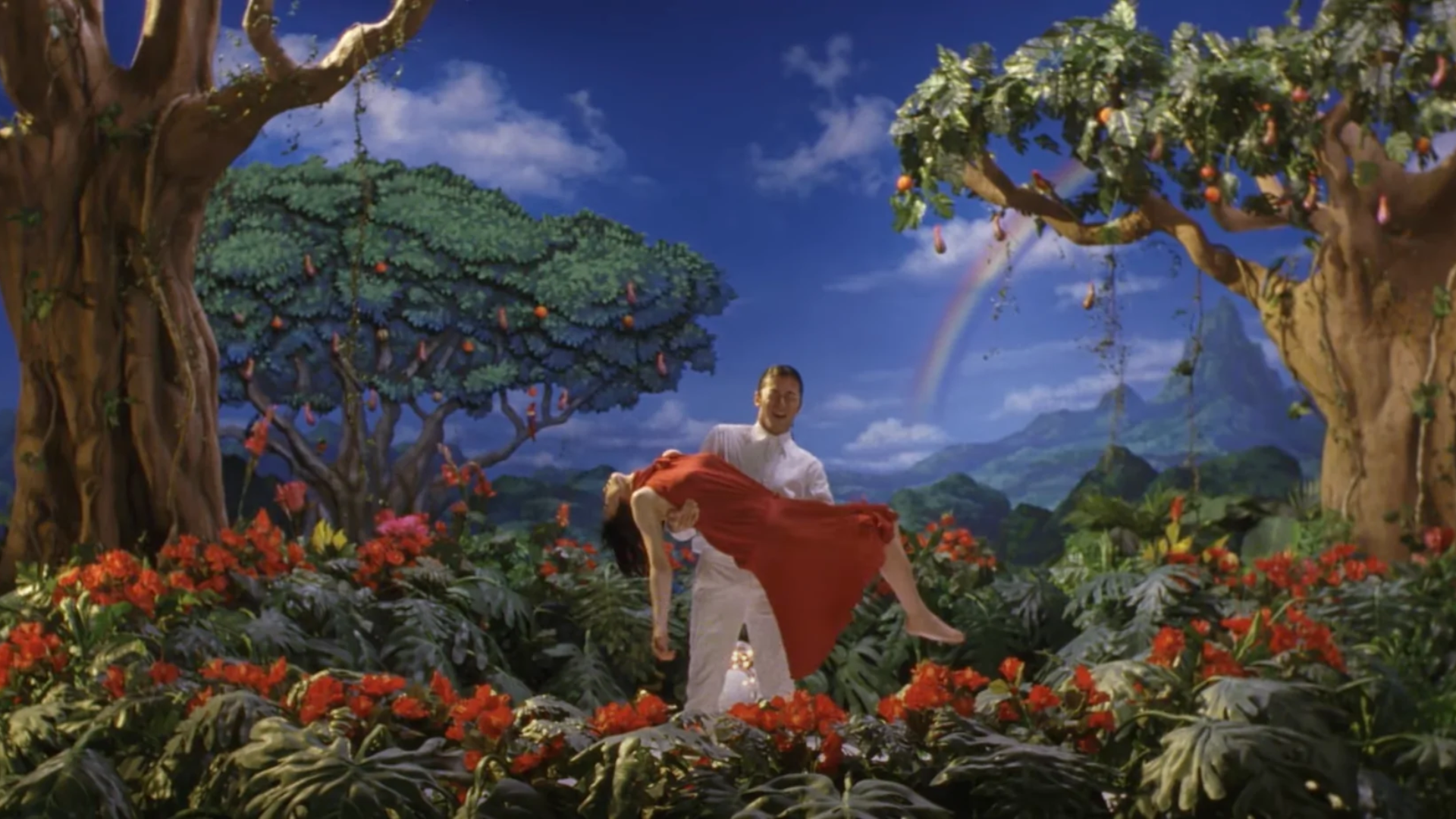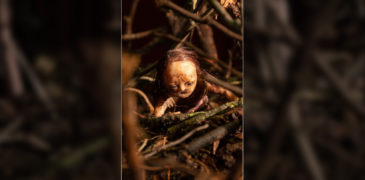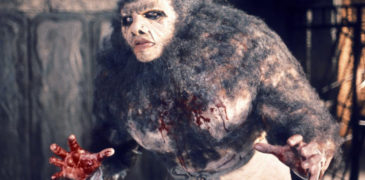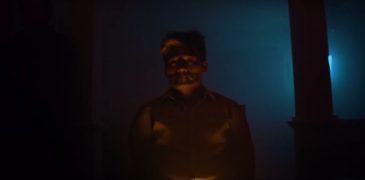
While anthologies can be slightly hit or miss at times, Rampo Noir seems determined to set itself apart. A lush and stylistic horror film with challenging eroticisms and unhinged humor, it presents four powerful segments from four directors with distinct cinematic styles, showcasing how Edogawa Ranpo’s masterful literature continues to inspire modern filmmakers.
The first segment, Mars Canal, introduces us to a naked man (Tadanobu Asano) wandering through a desolate, otherworldly landscape, silently navigating both the terrain and the ghosts of his past relationship. The eerie silence makes for a bizarre yet compelling opening—less chaotic than the rest but no less unsettling. The absence of sound underscores how chaos, no matter how loud and relentless, can become deafening to the perpetrator, numbing him to the gravity of his own actions. Only when consciousness returns does the weight of the deeds engulf him, leaving him isolated in his self-made abyss. It’s a chilling notion—that violence can become disturbingly effortless.
Directed by Japanese TV commercial director Suguru Takeuchi, Mars Canal is a disturbing yet less overtly gory adaptation of Rampo’s original story. Here, the man transforms into a woman, piercing through her own body until her skin is grotesquely distorted, resembling—fittingly—the canals of Mars. Despite its restrained depiction of violence, the film compensates with striking visuals: the stark, lonely landscape, the surreal allure of a vast lake that draws the protagonist in, and the moment of painful self-realization that follows. The theme of reflection and mirror is pivotal—suggesting that true understanding only arrives when everything is said and done. This theme carries over into the other three films in the anthology.

The second segment, Mirror Hell, is more straightforward yet equally unnerving. Adapted into a detective mystery by Glory of Vice and Ultraman director Akio Jissoji, it follows Detective Kogoro Akechi (played once again by Asano) as he investigates a series of murders involving women seemingly linked to a deranged mirror maker. A modernized Narcissus tale, Mirror Hell finds its strength in its blend of mythology and science, as the detective tries to unravel the grotesque events unfolding in an eerily quiet town with no clear traces of the killer.
As a follow-up to Mars Canal, Mirror Hell maintains the anthology’s artistic sensibilities through its hauntingly atmospheric visuals. Like its predecessor, it explores the human psyche, delving into philosophical musings on vanity and fragility. The theme of reflection continues—examining how self-obsession can spiral into destruction, affecting others in the name of self-preservation. Though more straightforward than Mars Canal, it still provokes thought, demanding viewers to reassess what they’ve just witnessed.

The third segment, The Caterpillar, directed by Naked Blood filmmaker Hisayasu Sato, serves as the anthology’s disturbing climax. Here, a woman (Nao Omori) alternates between tending to and tormenting her husband, who returns from war as a limbless husk. Isolated in an abandoned building, she refers to him as her caterpillar, believing he will one day transform into something new. The premise alone is unsettling, but the execution is far more harrowing on screen.
Depravity takes center stage in The Caterpillar, and its depiction of sex is even more unnerving than in Mirror Hell. It can be seen as an anti-war statement, given how war completely dismantles familial dynamics, while also carrying underlying feminist undertones. The woman, who previously existed solely through her husband’s heroism, discovers a new side of herself through her sexual escapades—a side that is subsequently stripped away when she is reduced to a mere caretaker. Also, she found herself a new pursuit by transforming her husband into her personal project.

Visually, the film leans into practical body horror, making for deeply uncomfortable viewing. Unlike Mirror Hell, which subdued its death scenes, The Caterpillar does not hold back, emphasizing how suppressed emotions and unchecked rage can fester into something grotesque. While certain elements of the original story were removed, the film compensates with disorienting imagery and bold color choices, staying true to the anthology’s arthouse aesthetic. The theme of reflection resurfaces, as mirrors are banned from the house—perhaps out of fear that her husband will see the horror he has become, or that she herself will be forced to confront the changes within her.
The final segment, Crawling Bugs, directed by manga artist Atsushi Kaneko, is arguably the most abstract, taking time for viewers to fully decipher. It follows a timid chauffeur (Asano) who becomes infatuated with an actress (Tamaki Ogawa). Driven by obsession, he kidnaps her, struggling to find a way to preserve her in captivity. The film returns to the noir sensibilities of Mirror Hell, but with a fragmented timeline that, while initially disorienting, ultimately immerses us in the chauffeur’s fractured psyche.

Arguably a more traditional body horror film than The Caterpillar, Crawling Bugs delves into existential dread, focusing on the fear of both internal and external decay. The motif of insects is explicit—his imagined infestations symbolize his own moral and physical rot. Yet the film’s final reveal makes the crawling bugs even more disturbing than their metaphorical implications. This segment also delivers a fitting conclusion to the anthology’s overarching mirror and reflection theme: the chauffeur is a voyeur, seeing the actress only through rearview mirrors and glass windows. His detachment from her reality—and his obsession with an illusion—ultimately seals his fate.
Rampo Noir delivers a gut-wrenching anthology that challenges both intellect and endurance, forcing viewers to confront their own thresholds for perversion and horror. It raises unsettling questions about the horrors lurking beneath human nature—horrors that, disturbingly, are not impossible in real life. With its rich thematic layers and mesmerizing visuals, there’s much to unpack. Fortunately, Arrow’s Limited Edition release offers a stunning high-definition transfer, allowing both new and longtime fans to fully appreciate the film’s intricate mise-en-scène and artistic depth.
Rampo Noir (2005) Is available to purchase from Arrow Films website here.
More Film Reviews
A bizarre blend of Phil Tippett’s Mad God and Dario Argento’s Suspiria, Robert Morgan’s feature debut Stopmotion (2023) is an indie horror film that weaponizes the maddening process of stop… Selected to cap off the closing night of Fright Fest 2021, The Advent Calendar has come to the attention of horror fans as one of the titles already announced as… In 1934, vaudevillian Will Hammer (real name William Hinds) diversified into the film industry. Hammer Productions Limited joined forces with Spanish entrepreneur Enrique Carreras to create Exclusive Films Limited, before… Dead Sushi is a 2012 Japanese splatter horror comedy film, written and directed by Noboru Iguchi, with additional writing from Makiko Iguchi and Jun Tsugita. Known for his over-the-top implementation… “We say revenge is like a river, whose bottom is reached only when we drown.” So begins this dark tale of violence steeped in politics and folk horror. A low-budget… The world of short films has always been an exciting one for those willing to embrace the format – both in giving insight into future filmmakers and offering short narrative…Stopmotion (2023) Film Review – The Magic of Animation
The Advent Calendar Film Review – Eat Chocolate or Die!
Frankenstein and the Monster from Hell (1974) Film Review | Hammer Horror
Dead Sushi (2012) Film Review – Sushi (S)Platter
Saloum (2021) Film Review – Genre-bending Senegalese Horror
Cult Affairs Short Film Review – Devil in the Details

I am a 4th year Journalism student from the Polytechnic University of the Philipines and an aspiring Filmmaker. I fancy found footage, home invasions, and gore films. Randomly unearthing good films is my third favorite thing in life. The second and first are suspending disbelief and dozing off.






